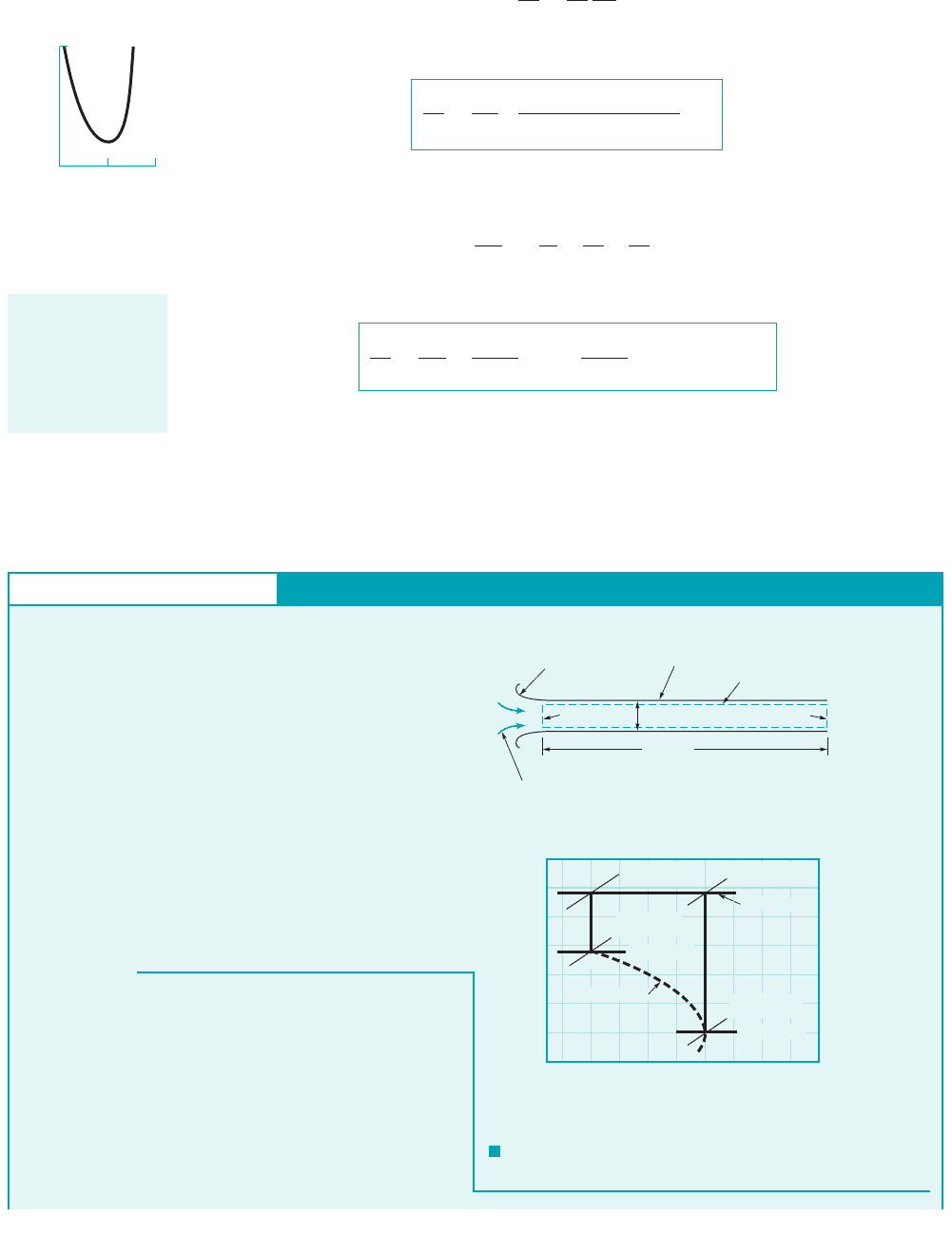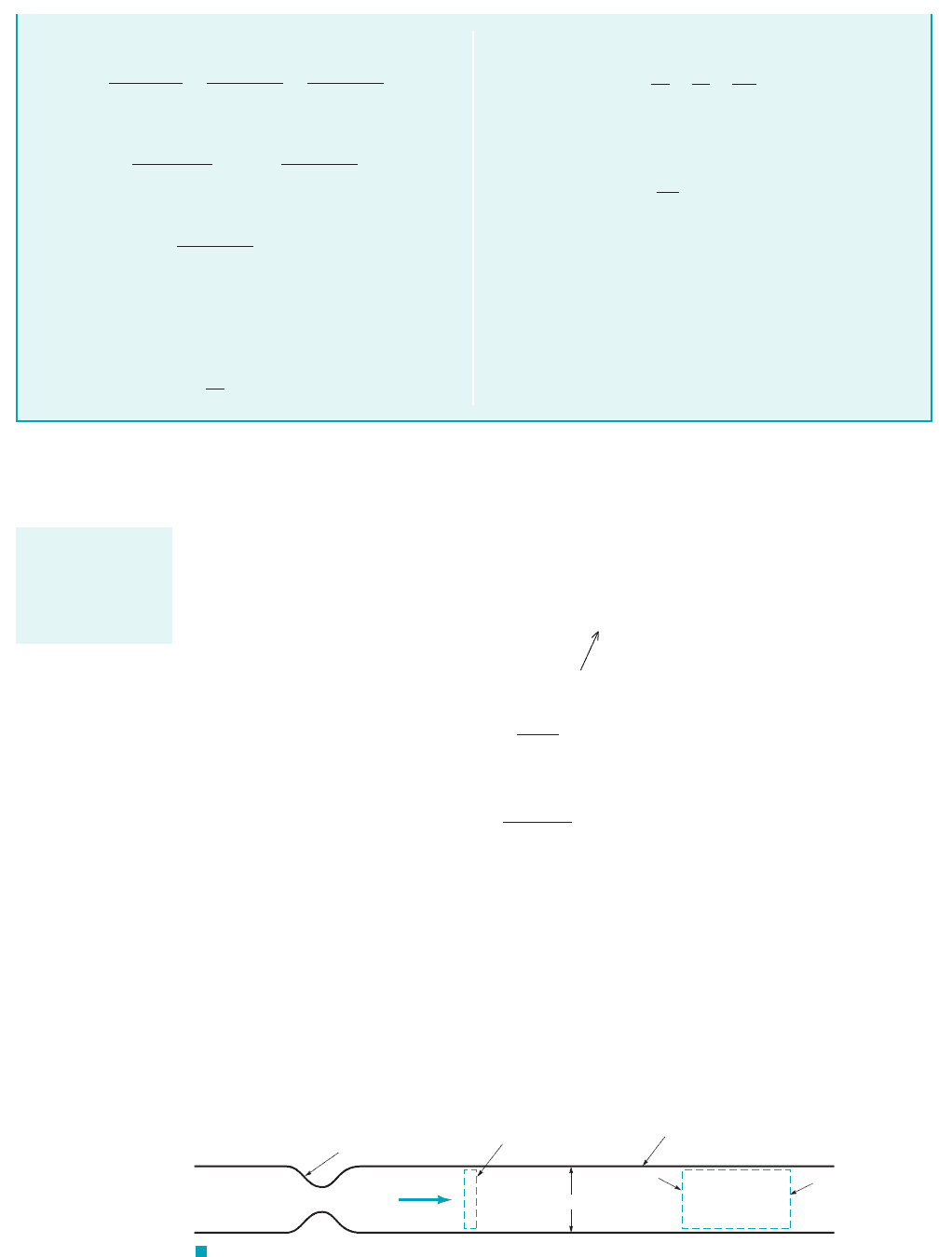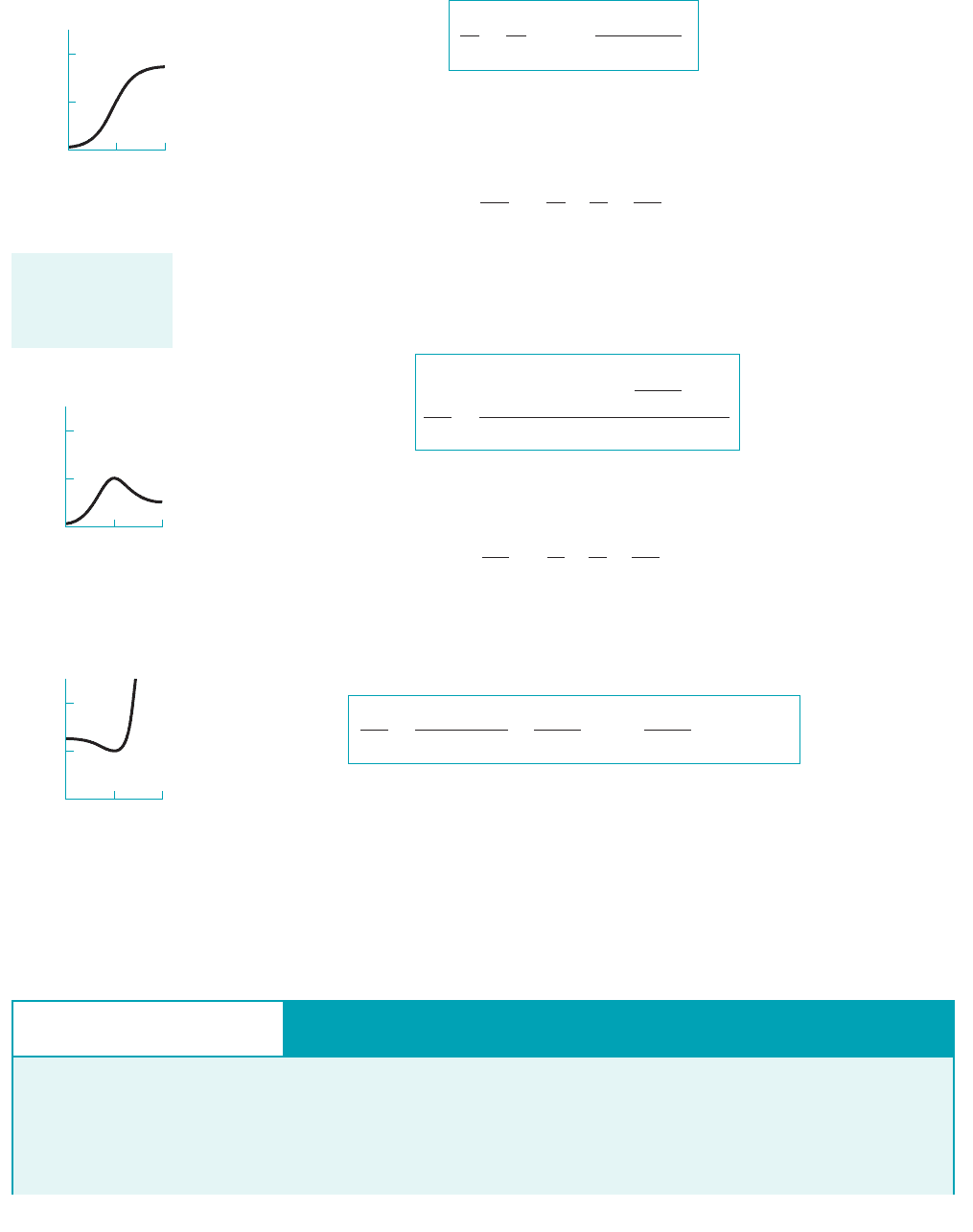Munson B.R. Fundamentals of Fluid Mechanics
Подождите немного. Документ загружается.


The ideal gas equation of state 1Eq. 11.12leads to
(11.106)
and merging Eqs. 11.106, 11.105, and 11.101 gives
(11.107)
This relationship is graphed in the margin for air.
Finally, the stagnation pressure ratio can be written as
(11.108)
which by use of Eqs. 11.59 and 11.107 yields
(11.109)
Values of for Fanno flow of air are
graphed as a function of Mach number 1using Eqs. 11.99, 11.101, 11.103, 11.107, and 11.1092in Fig.
D.2 of Appendix D. The usefulness of Fig. D.2 is illustrated in Examples 11.12, 11.13, and 11.14.
See Ref. 7 for additional compressible internal flow material.
1k ⫽ 1.42f 1/* ⫺ /2
Ⲑ
D, T
Ⲑ
T*, V
Ⲑ
V*, p
Ⲑ
p*, and p
0
Ⲑ
p
*
0
p
0
p
*
0
⫽
1
Ma
ca
2
k ⫹ 1
b a1 ⫹
k ⫺ 1
2
Ma
2
bd
31k⫹12
Ⲑ
21k⫺124
p
0
p
*
0
⫽ a
p
0
p
b a
p
p*
b a
p*
p
*
0
b
p
p*
⫽
1
Ma
e
1k ⫹ 12
Ⲑ
2
1 ⫹ 31k ⫺ 12
Ⲑ
24Ma
2
f
1
Ⲑ
2
p
p*
⫽
r
r*
T
T*
11.5 Nonisentropic Flow of an Ideal Gas 617
5.0
0.0
101.0
Ma
0.1
p
_
__
p*
For Fanno flow,
thermodynamic and
flow properties can
be calculated as a
function of Mach
number.
GIVEN Standard atmospheric air 101
is drawn steadily through a frictionless, adiabatic con-
verging nozzle into an adiabatic, constant area duct as shown in
Fig. E11.12a. The duct is 2 m long and has an inside diameter of
0.1 m. The average friction factor for the duct is estimated as be-
ing equal to 0.02.
FIND What is the maximum mass flowrate through the duct?
For this maximum flowrate, determine the values of static tem-
perature, static pressure, stagnation temperature, stagnation pres-
sure, and velocity at the inlet [section 112] and exit [section 122] of
the constant area duct. Sketch a temperature–entropy diagram for
this flow.
kPa1abs24
3T
0
⫽ 288 K, p
0
⫽
Choked Fanno Flow
E
XAMPLE 11.12
(b)
2
Fanno line
p
0.1
=
101 kPa (abs)
p
0.2
=
84 kPa (abs)
p
2
=
45 kPa (abs)
p
1
=
77 kPa (abs)
T
1
= 268 K
T
0
= 288 K
T
2
= 240 K
300
290
280
270
260
250
240
230
0 1020304050
T, K
s – s
1
,
J
_____
(kg
•
K)
1
F I G U R E E11.12
p
0
= 101 kPa (abs)
Frictionless and
adiabatic nozzle
Adiabatic duct with friction
factor
f = 0.02
Standard atmospheric air
T
0
= 288K
Control volume
Section (1) Section (2)
ᐉ = 2 m
(
a)
D = 0.1 m
S
OLUTION
We consider the flow through the converging nozzle to be isen-
tropic and the flow through the constant area duct to be Fanno
flow. A decrease in the pressure at the exit of the constant area
duct 1back pressure2causes the mass flowrate through the nozzle
and the duct to increase. The flow throughout is subsonic. The
maximum flowrate will occur when the back pressure is lowered
to the extent that the constant area duct chokes and the Mach
number at the duct exit is equal to 1. Any further decrease of back
pressure will not affect the flowrate through the nozzle–duct
combination.
JWCL068_ch11_579-644.qxd 9/25/08 8:21 PM Page 617

618 Chapter 11 ■ Compressible Flow
For the maximum flowrate condition, the constant area duct
must be choked, and
(1)
With for air and the above calculated value of
we could use Eq. 11.98 to determine a value of Mach
number at the entrance of the duct [section 112]. With and
Ma
1
known, we could then rely on Eqs. 11.101, 11.103, 11.107,
and 11.109 to obtain values of
Alternatively, for air we can use Fig. D.2 with
and read off values of and
The pipe entrance Mach number, also represents the Mach
number at the throat 1and exit2of the isentropic, converging nozzle.
Thus, the isentropic flow equations of Section 11.4 or Fig. D.1 can
be used with Ma
1
. We use Fig. D.1 in this example.
With known, we can enter Fig. D.1 and get values of
and Through the isentropic nozzle, the values
of and are each constant, and thus and can be
readily obtained.
Since also remains constant through the constant area duct
1see Eq. 11.752, we can use Eq. 11.63 to get Thus,
(2)
Since we get from Eq. 2,
(3)
(Ans)
With known, we can calculate from Eq. 11.36 as
Thus, since
we obtain
(4)
(Ans)
Now can be obtained from V* and Having and
we can get the mass flowrate from
(5)
Values of the other variables asked for can be obtained from the
ratios mentioned.
Entering Fig. D.2 with we read
(7)
(8)
(9)
(10)
(11)
p
0,1
p
*
0
⫽ 1.16
p
1
p*
⫽ 1.7
V
1
V*
⫽ 0.66
T
1
T*
⫽ 1.1
Ma
1
⫽ 0.63
f 1/* ⫺ /2
Ⲑ
D ⫽ 0.4
m
#
⫽ r
1
A
1
V
1
V
1
A
1
, r
1
,V
1
Ⲑ
V*.V
1
V* ⫽ 310 m
Ⲑ
s ⫽ V
2
1m
Ⲑ
s2
2
,1 J
Ⲑ
kg ⫽ 1 N
#
m
Ⲑ
kg ⫽ 1 1kg
#
m
Ⲑ
s
2
2
#
m
Ⲑ
kg ⫽
⫽ 310 1J
Ⲑ
kg2
1
Ⲑ
2
⫽ 231286.9 J2
Ⲑ
1kg
#
K241240 K211.42
V* ⫽ 1RT*k
V*T*
T* ⫽ 10.833321288 K2⫽ 240 K ⫽ T
2
T
0
⫽ 288 K,
T*
T
0
⫽
2
k ⫹ 1
⫽
2
1.4 ⫹ 1
⫽ 0.8333
T*.
T
0
r
1
T
1
, p
1
,r
0
T
0
, p
0
,
r
1
Ⲑ
r
0
.T
1
Ⲑ
T
0
, p
1
Ⲑ
p
0
,
Ma
1
Ma
1
,
p
0,1
Ⲑ
p
*
0
.
p
1
Ⲑ
p*,V
1
Ⲑ
V*,Ma
1
, T
1
Ⲑ
T*,D ⫽ 0.4
f1/* ⫺ /
1
2
Ⲑ
1k ⫽ 1.42,
p
1
Ⲑ
p*, and p
0,1
Ⲑ
p
*
0
.V
1
Ⲑ
V*,T
1
Ⲑ
T*,
k ⫽ 1.4
D ⫽ 0.4,
f1/* ⫺ /
1
2
Ⲑ
k ⫽ 1.4
f1/* ⫺ /
1
2
D
⫽
f1/
2
⫺ /
1
2
D
⫽
10.02212 m2
10.1 m2
⫽ 0.4
Entering Fig. D.1 with we read
(12)
(13)
(14)
Thus, from Eqs. 4 and 9 we obtain
(Ans)
From Eq. 14 we get
and from Eq. 5 we conclude that
(Ans)
From Eq. 12, it follows that
(Ans)
Equation 13 yields
(Ans)
The stagnation temperature, remains constant through this
adiabatic flow at a value of
(Ans)
The stagnation pressure, at the entrance of the constant area
duct is the same as the constant value of stagnation pressure
through the isentropic nozzle. Thus
(Ans)
To obtain the duct exit pressure we can use Eqs. 10 and
13. Thus,
(Ans)
For the duct exit stagnation pressure we can use Eq.
11 as
(Ans)
The stagnation pressure, decreases in a Fanno flow because of
friction.
COMMENT Use of graphs such as Figs. D.1 and D.2 illus-
trates the solution of a problem involving Fanno flow. The T–sdi-
agram for this flow is shown in Fig. E.11.12b, where the entropy
difference, is obtained from Eq. 11.22.s
2
⫺ s
1
,
p
0
,
⫽ 87.1 kPa1abs2
p
0,2
⫽ a
p*
0
p
0,1
b 1p
0,1
2⫽ a
1
1.16
b 3101 kPa1abs24
1p
0,2
⫽ p
*
0
2
⫽ 45 kPa1abs2
p
2
⫽ a
p*
p
1
b a
p
1
p
0,1
b 1p
0,1
2⫽ a
1
1.7
b 10.7623101 kPa1abs24
1p
2
⫽ p*2
p
0,1
⫽ 101 kPa1abs2
p
0
,
T
0,1
⫽ T
0,2
⫽ 288 K
T
0
,
p
1
⫽ 10.7623101 kPa1abs24⫽ 77 kPa1abs2
T
1
⫽ 10.9321288 K2⫽ 268 K
⫽ 1.65 kg
Ⲑ
s
m
#
⫽ 11.02 kg
Ⲑ
m
3
2 c
p10.1 m2
2
4
d 1206 m
Ⲑ
s2
r
1
⫽ 0.83r
0,1
⫽ 10.83211.23 kg
Ⲑ
m
3
2⫽ 1.02 kg
Ⲑ
m
3
V
1
⫽ 10.6621310 m
Ⲑ
s2⫽ 205 m
Ⲑ
s
r
1
r
0,1
⫽ 0.83
p
1
p
0,1
⫽ 0.76
T
1
T
0
⫽ 0.93
Ma
1
⫽ 0.63
JWCL068_ch11_579-644.qxd 9/25/08 8:22 PM Page 618

11.5 Nonisentropic Flow of an Ideal Gas 619
GIVEN The duct in Example 11.12 is shortened by 50%, but
the duct discharge pressure is maintained at the choked flow value
for Example 11.12, namely,
p
d
⫽ 45 kPa1abs2
Effect of Duct Length on Choked Fanno Flow
E
XAMPLE 11.13
S
OLUTION
which is read in Fig. D.1 for Thus,
(3)
We get from
(4)
from Fig. D.2 for The value of V* is the same as it
was in Example 11.12, namely,
(5)
Thus, from Eqs. 4 and 5 we obtain
(6)
and from Eqs. 1, 3, and 6 we get
(Ans)
The mass flowrate associated with a shortened tube is larger than
the mass flowrate for the longer tube, This trend is
general for subsonic Fanno flow.
COMMENT For the same upstream stagnation state and
downstream pressure, the mass flowrate for the Fanno flow will
decrease with increase in length of duct for subsonic flow. Equiv-
alently, if the length of the duct remains the same but the wall fric-
tion is increased, the mass flowrate will decrease.
m
#
⫽ 1.65 kg
Ⲑ
s.
⫽ 1.73 kg
Ⲑ
s
m
#
⫽ 10.97 kg
Ⲑ
m
3
2 c
p10.1m2
2
4
d 1226 m
Ⲑ
s2
V
1
⫽ 10.73213102⫽ 226 m
Ⲑ
s
V* ⫽ 310 m
Ⲑ
s
Ma
1
⫽ 0.7.
V
1
V*
⫽ 0.73
V
1
r
1
⫽ 10.79211.23 kg
Ⲑ
m
3
2⫽ 0.97 kg
Ⲑ
m
3
Ma
1
⫽ 0.7.
We guess that the shortened duct will still choke and check our
assumption by comparing with p*. If the flow is
choked; if not, another assumption has to be made. For choked flow
we can calculate the mass flowrate just as we did for Example 11.12.
For unchoked flow, we will have to devise another strategy.
For choked flow
and from Fig. D.2, we read the values
With we use Fig. D.1 and get
Now the duct exit pressure can be obtained from
and we see that Our assumption of choked flow is jus-
tified. The pressure at the exit plane is greater than the surround-
ing pressure outside the duct exit. The final drop of pressure
from 48.5 kPa1abs2to 45 kPa1abs2involves complicated three-
dimensional flow downstream of the exit.
To determine the mass flowrate we use
(1)
The density at section 112is obtained from
(2)
r
1
r
0,1
⫽ 0.79
m
#
⫽ r
1
A
1
V
1
p
d
6 p*.
⫽ a
1
1.5
b 10.7223101 kPa1abs24⫽ 48.5 kPa1abs2
p
2
⫽ p* ⫽ a
p*
p
1
b a
p
1
p
0,1
b 1p
0,1
2
1p
2
⫽ p*2
p
1
p
0
⫽ 0.72
Ma
1
⫽ 0.70,p* ⫽ 1.5.
Ma
1
⫽ 0.70 and p
1
Ⲑ
f 1/* ⫺ /
1
2
D
⫽
10.02211 m2
0.1 m
⫽ 0.2
p
d
6 p*,p
d
FIND Will shortening the duct cause the mass flowrate through
the duct to increase or decrease? Assume that the average friction
factor for the duct remains constant at a value of f ⫽ 0.02.
GIVEN The same flowrate obtained in Example 11.12
is desired through the shortened duct of Example 11.13
Assume f remains constant at a value of 0.02. 1/
2
⫺ /
1
⫽ 1 m2.
1.65 kg
Ⲑ
s2
1m
⫽
Unchoked Fanno Flow
E
XAMPLE 11.14
S
OLUTION
from Example 11.12, and from Fig. D.2
f 1/* ⫺ /
1
2
D
⫽ 0.4
Ma
1
⫽ 0.63Since the mass flowrate of Example 11.12 is desired, the Mach
number and other properties at the entrance of the constant area
duct remain at the values determined in Example 11.12. Thus,
FIND Determine the Mach number at the exit of the duct,
and the back pressure, required. p
2
,
M
2
,
JWCL068_ch11_579-644.qxd 9/25/08 8:22 PM Page 619

620 Chapter 11 ■ Compressible Flow
For this example,
or
so that
(1)
By using the value from Eq. 1 and Fig. D.2, we get
(Ans)
and
(2)
p
2
p*
⫽ 1.5
Ma
2
⫽ 0.70
f 1/* ⫺ /
2
2
D
⫽ 0.2
10.02211 m2
0.1 m
⫽ 0.4 ⫺
f 1/* ⫺ /
2
2
D
f 1/
2
⫺ /
1
2
D
⫽
f 1/* ⫺ /
1
2
D
⫺
f 1/* ⫺ /
2
2
D
We obtain from
where is given in Eq. 2 and and are
the same as they were in Example 11.12. Thus,
(Ans)
COMMENT A larger back pressure [68.0 kPa1abs2] than the
one associated with choked flow through a Fanno duct [45 kPa1abs2]
will maintain the same flowrate through a shorter Fanno duct with
the same friction coefficient. The flow through the shorter duct is not
choked. It would not be possible to maintain the same flowrate
through a Fanno duct longer than the choked one with the same fric-
tion coefficient, regardless of what back pressure is used.
⫽ 68.0 kPa1abs2
p
2
⫽ 11.52 a
1
1.7
b 10.7623101 kPa1abs24
p
0,1
p*
Ⲑ
p
1
, p
1
Ⲑ
p
0,1
,p
2
Ⲑ
p*
p
2
⫽ a
p
2
p*
b a
p*
p
1
b a
p
1
p
0,1
b 1p
0,1
2
p
2
11.5.2 Frictionless Constant Area Duct Flow with Heat Transfer
(Rayleigh Flow)
Consider the steady, one-dimensional, and frictionless flow of an ideal gas through the constant
area duct with heat transfer illustrated in Fig. 11.21. This is Rayleigh flow. Application of the
linear momentum equation 1Eq. 5.222to the Rayleigh flow through the finite control volume
sketched in Fig. 11.21 results in
01frictionless flow2
or
(11.110)
Use of the ideal gas equation of state 1Eq. 11.12in Eq. 11.110 leads to
(11.111)
Since the flow cross-sectional area remains constant for Rayleigh flow, from the continuity equa-
tion 1Eq. 11.402we conclude that
For a given Rayleigh flow, the constant in Eq. 11.111, the density–velocity product, and the
ideal gas constant are all fixed. Thus, Eq. 11.111 can be used to determine values of fluid temper-
ature corresponding to the local pressure in a Rayleigh flow.
To construct a temperature–entropy diagram for a given Rayleigh flow, we can use Eq. 11.76,
which was developed earlier from the second T ds relationship. Equations 11.111 and 11.76 can
be solved simultaneously to obtain the curve sketched in Fig. 11.22. Curves like the one in Fig.
11.22 are called Rayleigh lines.
rV,
rV ⫽ constant
p ⫹
1rV2
2
RT
p
⫽ constant
p ⫹
1rV2
2
r
⫽ constant
p
1
A
1
⫹ m
#
V
1
⫽ p
2
A
2
⫹ m
#
V
2
⫹ R
x
Rayleigh flow in-
volves heat transfer
with no wall fric-
tion and constant
cross-sectional area.
F I G U R E 11.21 Rayleigh flow.
Frictionless and adiabatic
converging–diverging duct
Semi-infinitesimal
control volume
Section (1)
Section (2)
Finite
control volume
Flow
Frictionless duct with
heat transfer
D = constant
JWCL068_ch11_579-644.qxd 9/25/08 8:22 PM Page 620

11.5 Nonisentropic Flow of an Ideal Gas 621
F I G U R E 11.22 Rayleigh line.
Ma < 1
Ma > 1
a (Ma
a
= 1)
Ma
b
=
b
T
s
( )
1
_
k
√
GIVEN Air enters [section 112] a frictionless, con-
stant flow cross-sectional area duct with the following properties
(the same as in Example 11.11):
p
1
⫽ 14.3 psia
T
1
⫽ 514.55 °R
T
0
⫽ 518.67 °R
1k ⫽ 1.42
Frictionless, Constant Area Compressible Flow
with Heat Transfer (Rayleigh Flow)
E
XAMPLE 11.15
FIND For Rayleigh flow, determine corresponding values of
fluid temperature and entropy change for various levels of down-
stream pressure and plot the related Rayleigh line.
S
OLUTION
To plot the Rayleigh line asked for, use Eq. 11.111
(1)
and Eq. 11.76
(2)
to construct a table of values of temperature and entropy change
corresponding to different levels of pressure downstream in a
Rayleigh flow.
Use the value of ideal gas constant for air from Table 1.7
or in EE system units
and the value of specific heat at constant pressure for air from Ex-
ample 11.11, namely,
Also, from Example 11.11, For the
given inlet [section 112] conditions, we get
Thus, from Eq. 1 we get
⫽ 14.3 psia ⫹ 3720 lbm
Ⲑ
1ft
#
s
2
2⫽ constant
p ⫹
1rV2
2
RT
p
⫽ 14.3 psia ⫹ 316.7 lbm
Ⲑ
1ft
2
#
s24
2
113.3 ft
3
Ⲑ
lbm2
⫽ 13.3 ft
3
Ⲑ
lbm
RT
1
p
1
⫽
353.3 1ft
#
lb2
Ⲑ
1lbm
#
°R241514.55 °R2
14.3 psia 1144 in.
2
Ⲑ
ft
2
2
rV ⫽ 16.7 lbm
Ⲑ
1ft
2
#
s2.
c
p
⫽ 187 1ft
#
lb2
Ⲑ
1lbm
#
°R2
R ⫽ 53.3 1ft
#
lb2
Ⲑ
1lbm
#
°R2
R ⫽ 1716 1ft
#
lb2
Ⲑ
1slug
#
°R2
s ⫺ s
1
⫽ c
p
ln
T
T
1
⫺ R ln
p
p
1
p ⫹
1rV2
2
RT
p
⫽ constant
or, since
(3)
With the downstream pressure of psia, we can obtain
the downstream temperature by using Eq. 3 with the fact that
Hence, from Eq. 3,
or
From Eq. 2 with the downstream pressure and tem-
perature we get
By proceeding as outlined above, we can construct the table of
values shown below and graph the Rayleigh line of Fig. E11.15.
s ⫺ s
1
⫽ 121 1ft
#
lb2
Ⲑ
1lbm
#
°R2
⫺ 353.3 1ft
#
lb2
Ⲑ
1lbm
#
°R24 ln a
13.5 psia
14.3 psia
b
s ⫺ s
1
⫽ 3187 1ft
#
lb2
Ⲑ
1lbm
#
°R24 ln a
969 °R
514.55 °R
b
T ⫽ 969 °R
p ⫽ 13.5 psia
T ⫽ 969 °R
13.5 psia ⫹ 31.65 ⫻ 10
⫺3
1lb
Ⲑ
in.
2
2
Ⲑ
°R4 T ⫽ 15.10 psia
⫽ 1.65 ⫻ 10
⫺3
1lb
Ⲑ
in.
2
2
Ⲑ
°R
⫽ 0.238 1lb
Ⲑ
ft
2
2
Ⲑ
°R11 ft
2
Ⲑ
144 in.
2
2
⫽ 7.65 3lbm
Ⲑ
1ft
#
s
2
24
Ⲑ
°R 31 lb
Ⲑ
132.2 lbm
#
ft
Ⲑ
s
2
24
1rV2
2
R
p
⫽
316.7 lbm
Ⲑ
1ft
2
#
s24
2
353.3 1ft
#
lb2
Ⲑ
1lbm
#
°R24
1144 in.
2
Ⲑ
ft
2
2 13.5 psia
p ⫽ 13.5
⫽ 15.10 psia ⫽ constant
p ⫹
1rV2
2
RT
p
⫽ 14.3 psia ⫹ 313720
Ⲑ
32.22lb
Ⲑ
ft
2
411 ft
2
Ⲑ
144 in.
2
2
lb
Ⲑ
ft
2
,32.22
11
Ⲑ
1 lbm
Ⲑ
1ft
#
s
2
2⫽ 311
Ⲑ
32.221lb
#
s
2
Ⲑ
ft24
Ⲑ
1ft
#
s
2
2⫽
JWCL068_ch11_579-644.qxd 9/25/08 8:23 PM Page 621

622 Chapter 11 ■ Compressible Flow
COMMENT Depending on whether the flow is being heated or
cooled, it can proceed in either direction along the curve.
F I G U R E E11.15
pT
(psia) ( ) [( ) ( )]
13.5 969 9.32
12.5 1459 202
11.5 1859 251
10.5 2168 285
9.0 2464 317
8.0 2549 330
7.6 2558 333
7.5 2558 334
7.0 2544 336
6.3 2488 338
6.0 2450 338
5.5 2369 336
5.0 2266 333
4.5 2140 328
4.0 1992 321
2.0 1175 259
1.0 633 181
lbm R
Ⲑ
ft lbR
s s
1
3000
2500
2000
1500
1000
500
100 200 300
T, °R
s – s
1
,
(ft
•
lb)
________
(lbm
•
°R)
At point a on the Rayleigh line of Fig. 11.22, To determine the physical impor-
tance of point a, we analyze further some of the governing equations. By differentiating the linear
momentum equation for Rayleigh flow 1Eq. 11.1102we obtain
or
(11.112)
Combining Eq. 11.112 with the second T ds equation 1Eq. 11.182leads to
(11.113)
For an ideal gas 1Eq. 11.72 Thus, substituting Eq. 11.7 into Eq. 11.113 gives
or
(11.114)
Consolidation of Eqs. 11.114, 11.112 1linear momentum2, 11.1, 11.77 1differentiated equation of
state2, and 11.79 1continuity2leads to
(11.115)
Hence, at state a where Eq. 11.115 reveals that
(11.116)
Comparison of Eqs. 11.116 and 11.36 tells us that the Mach number at state a is equal to 1,
(11.117)
At point b on the Rayleigh line of Fig. 11.22, From Eq. 11.115 we get
dT
ds
⫽
1
ds
Ⲑ
dT
⫽
1
1c
p
Ⲑ
T2⫹ 1V
Ⲑ
T231T
Ⲑ
V2⫺ 1V
Ⲑ
R24
⫺1
dT
Ⲑ
ds ⫽ 0.
Ma
a
⫽ 1
V
a
⫽ 1RT
a
k
ds
Ⲑ
dT ⫽ 0,
ds
dT
⫽
c
p
T
⫹
V
T
1
31T
Ⲑ
V2⫺ 1V
Ⲑ
R24
ds
dT
⫽
c
p
T
⫹
V
T
dV
dT
T ds ⫽ c
p
dT ⫹ V dV
dh
ˇ
⫽ c
p
dT.
T ds ⫽ dh
ˇ
⫹ V dV
dp
r
⫽⫺V dV
dp ⫽⫺rV dV
ds
Ⲑ
dT ⫽ 0.
The maximum
entropy state on the
Rayleigh line corre-
sponds to sonic
conditions.
JWCL068_ch11_579-644.qxd 9/25/08 8:23 PM Page 622

which for 1point b2gives
(11.118)
The flow at point b is subsonic Recall that for any gas.
To learn more about Rayleigh flow, we need to consider the energy equation in addition to
the equations already used. Application of the energy equation 1Eq. 5.692to the Rayleigh flow
through the finite control volume of Fig. 11.21 yields
01negligibly small 01flow is steady
for gas flow2 throughout2
or in differential form for Rayleigh flow through the semi-infinitesimal control volume of Fig. 11.21
(11.119)
where is the heat transfer per unit mass of fluid in the semi-infinitesimal control volume.
By using in Eq. 11.119, we obtain
(11.120)
Thus, by combining Eqs. 11.36 1ideal gas speed of sound2, 11.46 1Mach number2, 11.1 and 11.77
1ideal gas equation of state2, 11.79 1continuity2, and 11.112 1linear momentum2with Eq. 11.120 1en-
ergy2we get
(11.121)
With the help of Eq. 11.121, we see clearly that when the Rayleigh flow is subsonic
fluid heating increases fluid velocity while fluid cooling decreases fluid ve-
locity. When Rayleigh flow is supersonic fluid heating decreases fluid velocity and fluid
cooling increases fluid velocity.
The second law of thermodynamics states that, based on experience, entropy increases with
heating and decreases with cooling. With this additional insight provided by the conservation of
energy principle and the second law of thermodynamics, we can say more about the Rayleigh
line in Fig. 11.22. A summary of the qualitative aspects of Rayleigh flow is outlined in Table
11.2 and Fig. 11.23. Along the upper portion of the line, which includes point b, the flow is sub-
sonic. Heating the fluid results in flow acceleration to a maximum Mach number of 1 at point
a. Note that between points b and a along the Rayleigh line, heating the fluid results in a tem-
perature decrease and cooling the fluid leads to a temperature increase. This trend is not surpris-
ing if we consider the stagnation temperature and fluid velocity changes that occur between
points a and b when the fluid is heated or cooled. Along the lower portion of the Rayleigh curve
the flow is supersonic. Rayleigh flows may or may not be choked. The amount of heating or
cooling involved determines what will happen in a specific instance. As with Fanno flows, an
abrupt deceleration from supersonic flow to subsonic flow across a normal shock wave can also
occur in Rayleigh flows.
1Ma 7 12,
1dq 6 021dq 7 02
1Ma 6 12,
dV
V
⫽
dq
c
p
T
1
11 ⫺ Ma
2
2
dV
V
⫽
dq
c
p
T
c
V
T
dT
dV
⫹
V
2
1k ⫺ 12
kRT
d
⫺1
dh
ˇ
⫽ c
p
dT ⫽ Rk dT
Ⲑ
1k ⫺ 12
dq
dh
ˇ
⫹ V dV ⫽ dq
m
#
ch
ˇ
2
⫺ h
ˇ
1
⫹
V
2
2
⫺ V
1
2
2
⫹ g1z
2
⫺ z
1
2d⫽ Q
#
net
in
⫹ W
#
shaft
net in
k 7 11Ma
b
6 1.02.
Ma
b
⫽
B
1
k
dT
Ⲑ
ds ⫽ 0
11.5 Nonisentropic Flow of an Ideal Gas 623
TABLE 11.2
Summary of Rayleigh Flow Characteristics
Heating Cooling
Acceleration Deceleration
Deceleration AccelerationMa 7 1
Ma 6 1
Fluid temperature
reduction can ac-
company heating a
subsonic Rayleigh
flow.
JWCL068_ch11_579-644.qxd 9/25/08 8:24 PM Page 623

To quantify Rayleigh flow behavior we need to develop appropriate forms of the governing
equations. We elect to use the state of the Rayleigh flow fluid at point a of Fig. 11.22 as the refer-
ence state. As shown earlier, the Mach number at point a is 1. Even though the Rayleigh flow be-
ing considered may not choke and state a is not achieved by the flow, this reference state is useful.
If we apply the linear momentum equation 1Eq. 11.1102to Rayleigh flow between any up-
stream section and the section, actual or imagined, where state a is attained, we get
or
(11.122)
By substituting the ideal gas equation of state 1Eq. 11.12into Eq. 11.122 and making use of the ideal
gas speed-of-sound equation 1Eq. 11.362and the definition of Mach number 1Eq. 11.462, we obtain
(11.123)
This relationship is graphed in the margin for air.
From the ideal gas equation of state 1Eq. 11.12we conclude that
(11.124)
Conservation of mass 1Eq. 11.402with constant A gives
(11.125)
which when combined with Eqs. 11.36 1ideal gas speed of sound2and 11.46 1Mach number defi-
nition2gives
(11.126)
Combining Eqs. 11.124 and 11.126 leads to
(11.127)
which when combined with Eq. 11.123 gives
(11.128)
T
T
a
⫽ c
11 ⫹ k2Ma
1 ⫹ kMa
2
d
2
T
T
a
⫽ a
p
p
a
Mab
2
r
a
r
⫽ Ma
B
T
T
a
r
a
r
⫽
V
V
a
T
T
a
⫽
p
p
a
r
a
r
p
p
a
⫽
1 ⫹ k
1 ⫹ kMa
2
p
p
a
⫹
rV
2
p
a
⫽ 1 ⫹
r
a
p
a
V
a
2
p ⫹ rV
2
⫽ p
a
⫹ r
a
V
a
2
624 Chapter 11 ■ Compressible Flow
2.0
1.0
0.0
101.0
Ma
0.1
T
__
T
a
2.0
1.0
0.0
101.0
Ma
0.1
p
__
p
a
F I G U R E 11.23 (a) Subsonic Rayleigh flow. (b) Supersonic Rayleigh flow. (c) Normal
shock in a Rayleigh flow.
T
s
(a)
T
s
(b)
T
s
(c)
Normal shock
b
a
b
a
b
a
Heating
Heating
Heating
Cooling
Cooling
Heating
Cooling
JWCL068_ch11_579-644.qxd 9/25/08 8:24 PM Page 624

This relationship is graphed in the margin on the previous page for air.
From Eqs. 11.125, 11.126, and 11.128 we see that
(11.129)
This relationship is graphed in the margin for air.
The energy equation 1Eq. 5.692tells us that because of the heat transfer involved in Rayleigh
flows, the stagnation temperature varies. We note that
(11.130)
We can use Eq. 11.56 1developed earlier for steady, isentropic, ideal gas flow2to evaluate and
because these two temperature ratios, by definition of the stagnation state, involve isentropic
processes. Equation 11.128 can be used for Thus, consolidating Eqs. 11.130, 11.56, and
11.128 we obtain
(11.131)
This relationship is graphed in the margin for air.
Finally, we observe that
(11.132)
We can use Eq. 11.59 developed earlier for steady, isentropic, ideal gas flow to evaluate and
because these two pressure ratios, by definition, involve isentropic processes. Equation
11.123 can be used for Together, Eqs. 11.59, 11.123, and 11.132 give
(11.133)
This relationship is graphed in the margin for air.
Values of or and are graphed in Fig. D.3 of Appendix D
as a function of Mach number for Rayleigh flow of air The values in Fig. D.3 were calcu-
lated from Eqs. 11.123, 11.128, 11.129, 11.131, and 11.133. The usefulness of Fig. D.3 is illustrated
in Example 11.16.
See Ref. 7 for a more advanced treatment of internal flows with heat transfer.
1k ⫽ 1.42.
p
0
Ⲑ
p
0,a
V
Ⲑ
V
a
, T
0
Ⲑ
T
0,a
,p
Ⲑ
p
a
, T
Ⲑ
T
a
, r
Ⲑ
r
a
p
0
p
0,a
⫽
11 ⫹ k2
11 ⫹ kMa
2
2
ca
2
k ⫹ 1
b a1 ⫹
k ⫺ 1
2
Ma
2
bd
k
Ⲑ
1k⫺12
p
Ⲑ
p
a
.
p
a
Ⲑ
p
0,a
p
0
Ⲑ
p
p
0
p
0,a
⫽ a
p
0
p
b
a
p
p
a
b a
p
a
p
0,a
b
T
0
T
0,a
⫽
21k ⫹ 12Ma
2
a1 ⫹
k ⫺ 1
2
Ma
2
b
11 ⫹ kMa
2
2
2
T
Ⲑ
T
a
.
T
a
Ⲑ
T
0a
T
0
Ⲑ
T
T
0
T
0,a
⫽ a
T
0
T
b
a
T
T
a
b a
T
a
T
0,a
b
r
a
r
⫽
V
V
a
⫽ Ma c
11 ⫹ k2Ma
1 ⫹ kMa
2
d
11.5 Nonisentropic Flow of an Ideal Gas 625
2.0
1.0
0.0
101.0
Ma
0.1
V
___
V
a
ρ
___
r
a
,
2.0
1.0
0.0
101.0
Ma
0.1
T
0___
T
0,a
Unlike Fanno flow,
the stagnation tem-
perature in Ray-
leigh flow varies.
2.0
1.0
0.0
101.0
Ma
0.1
p
0
___
p
0,a
GIVEN The information in Table 11.2 shows us that subsonic
Rayleigh flow accelerates when heated and decelerates when
cooled. Supersonic Rayleigh flow behaves just opposite to sub-
sonic Rayleigh flow; it decelerates when heated and accelerates
when cooled.
Effect of Mach Number and Heating/Cooling
for Rayleigh Flow
FIND Using Fig. D.3 for air state whether velocity,
Mach number, static temperature, stagnation temperature, static
pressure, and stagnation pressure increase or decrease as subsonic
and supersonic Rayleigh flow is 1a2heated, 1b2cooled.
1k ⫽ 1.42,
E
XAMPLE 11.16
JWCL068_ch11_579-644.qxd 9/25/08 8:24 PM Page 625

626 Chapter 11 ■ Compressible Flow
Heating Cooling
Subsonic Supersonic Subsonic Supersonic
V Increase Decrease Decrease Increase
Ma Increase Decrease Decrease Increase
T Increase for Increase Decrease for Decrease
Decrease for Increase for
Increase Increase Decrease Decrease
p Decrease Increase Increase Decrease
Decrease Decrease Increase Increasep
0
T
0
ⱕ 1ⱕ 1
11
Ⲑ
k ⱕ Ma11
Ⲑ
k ⱕ Ma
11
Ⲑ
k11
Ⲑ
k
0 ⱕ Ma ⱕ0 ⱕ Ma ⱕ
11.5.3 Normal Shock Waves
As mentioned earlier, normal shock waves can occur in supersonic flows through converging–
diverging and constant area ducts. Past experience suggests that normal shock waves involve de-
celeration from a supersonic flow to a subsonic flow, a pressure rise, and an increase of entropy.
To develop the equations that verify this observed behavior of flows across a normal shock, we ap-
ply first principles to the flow through a control volume that completely surrounds a normal shock
wave 1see Fig. 11.242. We consider the normal shock and thus the control volume to be infinitesi-
mally thin and stationary.
For steady flow through the control volume of Fig. 11.24, the conservation of mass princi-
ple yields
(11.134)
because the flow cross-sectional area remains essentially constant within the infinitesimal thickness
of the normal shock. Note that Eq. 11.134 is identical to the continuity equation used for Fanno and
Rayleigh flows considered earlier.
The friction force acting on the contents of the infinitesimally thin control volume surround-
ing the normal shock is considered to be negligibly small. Also for ideal gas flow, the effect of
gravity is neglected. Thus, the linear momentum equation 1Eq. 5.222describing steady gas flow
through the control volume of Fig. 11.24 is
or for an ideal gas for which
(11.135)
Equation 11.135 is the same as the linear momentum equation for Rayleigh flow, which was de-
rived earlier 1Eq. 11.1112.
p ⫹
1rV2
2
RT
p
⫽ constant
p ⫽ rRT,
p ⫹ rV
2
⫽ constant
rV ⫽ constant
V11.7 Blast waves
Normal shock
waves are assumed
to be infinitesimally
thin discontinuities.
S
OLUTION
heating and friction cause the stagnation pressure to decrease.
Since stagnation pressure loss is considered undesirable in terms
of fluid mechanical efficiency, heating a fluid flow must be ac-
complished with this loss in mind.
COMMENT Note that for a small range of Mach numbers
cooling actually results in a rise in temperature, T.
Acceleration occurs when in Fig. D.3 increases. For decel-
eration, decreases. From Fig. D.3 and Table 11.2 the follow-
ing chart can be constructed.
From the Rayleigh flow trends summarized in the table above,
we note that heating affects Rayleigh flows much like friction af-
fects Fanno flows. Heating and friction both accelerate subsonic
flows and decelerate supersonic flows. More importantly, both
V
Ⲑ
V
a
V
Ⲑ
V
a
JWCL068_ch11_579-644.qxd 9/25/08 8:24 PM Page 626
